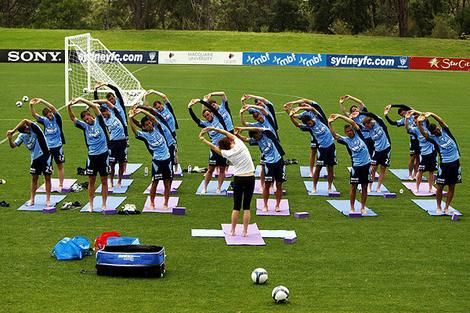Tag Archives: yoga
8/30 Quote: Guillaume Apollinaire
“Now and then it’s good to pause in our pursuit of happiness and just be happy.” ~Guillaume Apollinaire
9 Tips to Avoid Distracted Living and Become Mindful
Texting while driving has killed thousands in the US and states have passed legislation to outlaw, “distracted driving.”
I’m trying to reduce my own tendencies of “distracted living.” Although it’s not as deadly as distracted driving, distracted living can have negative consequences leading us to seek instant gratification instead of spiritual truths and causing us to miss out on what’s happening in the present moment.
Society has programmed us to live this way: we’re bombarded by hundreds of advertisements each day, we spend countless hours sitting behind computer screens, and we communicate with each other instantaneously via electronic devices.
On a typical weekday, a five minute snapshot of my morning looks something like this: a pop+up advertisement window to an interesting article, a text message from a friend, a business idea comes to me, a random thought about the past surfaces…. I’ve been struggling to focus on the present moment.
It’s a challenge and a goal for me to “Be here now” in whatever I’m doing and I often find my mind wandering. How can we slow down our “monkey minds” to increase stillness? Here are a few practices to help avoid distracted living and to incorporate mindfulness.
1. Turn the phone off
One of the best parts about traveling is being disconnected from the world and not having a phone. Instead of playing a meaningless iPhone game or having a trivial text message conversation, turn the phone off for an extended period of time. (a day, a weekend, day I say a week?)
Here’s a post w/ tips to reduce cell phone dependence
2. Go for a walk
When I’ve been sitting at the computer for too long, I’ll drop everything and go for a walk. Walking outside in nature is preferred but even a walk around a building inside can help you become more attuned with the present moment. Even if it’s only a 5 minute walk, it can change the complexion of your day.
3. Read a book
Whether it’s fiction or none, reading will help anxiety subside and help you become more present.
Photo of me reading at the beach, courtesy of Danielle Lussier:
4. Exercise
Exercise releases endorphins, increases blood flow, and helps us focus on the present moment.
5. Get in nature
No phone, no technology. Just you and the natural environment. You’ll notice all sorts of life forms around you and be inspired by nature’s inherent beauty.
“There is nothing quite like immersion in Nature to restore a sense of wholeness to the soul.” ~Tim Miller
6. Meditate
I have a friend who meditates in several short bursts throughout the day while he’s at work. He’ll turn his back from the computer and focus deeply on the present moment for short spans of time (30 seconds, 1 minute.) He says it helps him to be more aware and creative throughout the day.
A Short and East Meditation for Beginners
Great tips on how to create a relaxing home meditation space: here.
7. Do a few yoga postures
It’s wild how doing two or three yoga postures can drastically change your day. Instead of reacting to external stimuli all day, you’re able to move the prana (energy) and blood throughout your body. Your spine and chakras become realigned and you start to feel alive 🙂
A one minute standing forward bend will drastically improve your day by sending prana to your brain, stretching your hamstrings, and activating your spine thus decreasing anxiety and calming the mind.

8. Turn the TV off
There are some people who literally cannot sleep without the TV on (I used to be one of them.) How can one listen to what’s going on within their own body if they’re always being bombarded with external stimuli such as TV and cell phone messages?
9. Breathe
Not the automated breathing that we use 99% of the time. Instead, the yogic, ujjayi breathing that steadies the mind. It’s incredible what 3 deep, even, focused inhales and exhales through the nose can do.
Click here for more tips on how to feel alive naturally.
What are other tips to be more aware of the present moment and to reduce distracted living?
Beautiful Rendition of Ashtanga Yoga Opening Mantra
Sports and Yoga: Seattle Seahawks Mind-Body Training
From Alyssa Roenigk’s and ESPN The Magazine:
“IT’S DIFFERENT HERE,” Pete Carroll says. “Have you noticed?” It’s hard not to. At 9 a.m. on the first Sunday of training camp in Renton, Wash., high-performance sports psychologist Mike Gervais, dressed in a navy Seahawks hoodie and white baseball cap and flashing more enthusiasm than is rational at this hour, welcomes players into a meeting room at the Virginia Mason Athletic Center. This place used to be the site of a coal tar refinery; now it’s the happiest, greenest campsite in the history of the NFL. Gervais is about to lead a meditation session and, as he always does, instructs the players to hit record on their phone voice-recorder apps and to close their eyes. Then he starts guiding them: “Quiet your minds,” “Focus your attention inwardly” and “Visualize success.”
“On this Sunday morning, it starts with meditation with Gervais, whom Carroll began to integrate into the program in 2011, at first working on the fringes as a consultant, then becoming a sideline regular last year. For the newcomers to his sessions, Gervais keeps them short, about six minutes. For those with some experience, he prepares longer, more individualized meditations. No one is required to be here, yet about 20 players show up at various times every week to breathe in, breathe out and open their minds. The entire roster also participates in yoga class, which players enjoyed so much last year as an optional activity that the staff decided to make it a mandated part of player workouts this year.”
“The big idea is that happy players make for better players. Everyone in the facility, from coaches and players to personal assistants and valets, is expected to follow Carroll’s mantras regarding positivity of thought, words and actions. “Do your job better than it has ever been done before,” he tells them. Yelling and swearing are frowned upon, and every media interview with a player or coach ends with a thank-you to the reporter. And in a trial program entering its second year, a group of 15 to 20 players is undergoing Neurotopia brain-performance testing and has worked with Gervais to create status profiles — updated every week on an iPad app — of what’s going on in their lives, how much sleep they’re getting, their goals and how they’re dealing with stressors.”
Read more about the Seattle Seahawks and yoga, meditation, and mindfulness.
The Yamas: What is Brahmacharya? What is it to you?
What is Brahmacharya?
In recent posts, we’ve discussed many Yamas and Niyamas of Yoga, but what is Brahmacharya?
The Yamas are the first limb on yoga’s eight-limbed path. They are ethical disciplines Yogis live their lives by.
In the last few weeks we have wrote about the four other Yamas: ahimsa, satya, asteya, and aparigraha.
Today we focus on Brahmacharya.
What is Brahmacharya translated in English?
According to the dictionary brahmacharya means the life of celibacy, religious study, and self-restraint.
Our teacher, Rory Trollen, taught us that “Brah” means Creator. Macharya means “follow.” Rory said, “Brahmacharya is the fundamental source of our being. Since it is the source of our being, this is where our sexual energy comes from.”
We were all created by sexual energy and desire. A lot of our thoughts, as Nietzsche has elaborated on, have come from this strong sense of sexual desire and desire to reproduce. Our creativity comes from Our Source.
This Yama in yoga teaches us to use our energy to follow our Source, our Creator, and our God, whoever that may be, to you.
What is Brahmacharya in relation to celibacy?
A lot of teachers say that practicing brahmacharya is practicing a life of celibacy. Like all traditional spiritual traditions, yoga advocates restraining from indulging in sensual gratification. One of the many reasons is that practicing the higher limbs of yoga – dharana, dhyana, samadhi – requires a tremendous amount of energy or prana. This energy is built up through the practices of yoga such as asanas, pranayama and japa but is dissipated during sensual enjoyment. Of all the sensual activities, sex is the one that will be the most depleting to the psychic and nervous system. Teachers say that one should practice brahmacharya to the best of their ability. Obviously there are more extreme yogis out there and less extreme.
What is Brahmacharya? How I Follow the principles of Brahmacharya
I use Brahmacharya to act as a discipline to follow God and myself. To get on the mat and practice. To listen to what we want, and to listen to what others want. To love.
Our teacher stressed to use Brahmacharya as a symbol to follow the great teachers. He told us, “Don’t be sheep. 95% of people are sheep adapting and subscribing to a social environment. They are impacted greatly by what others think of them. They are swadhisthana.”

Have you ever felt like a sheep being herded during your daily morning commute? Become the Maripuna of your life! (image credit: veracityvoice.com)
Instead he told us to fight to be manipura. “Manipuras are the shephards. The ones who want to lead themselves. The ones who want to be themselves. The ones who want to love themselves. They are the ones who use brahmacharya to follow their path.”
What is brahmacharya to you? How do you use this Yama in your life?
We are learners. We would love to hear how others use this powerful Yama, beyond “Don’t have sex.” How does it make you? Change you? We hope to learn from every one of you who read all the way through to this. Let’s hear your thoughts in the comments section of this post!
Kino: Top 10 Yoga Postures for Strength
Yoga is more than just stretching and relaxation. Daily yoga practice includes a comprehensive system that builds strength in the body and mind. My journey in yoga has been from weakness to strength in every sense possible. There are some key postures that helped me access the deep reservoir of inner fortitude that every person contains within. The 10 postures outlined below will help you develop the strength and stamina needed to truly build core power in your yoga practice. If you feel any of these postures are too easy, just hold the posture for one full minute while maintaining healthy alignment to test your strength and steadiness of mind and body. There are so many amazing postures that build strength in yoga that it was hard to choose the top 10, but I’ve selected postures that contain the foundational alignment and strength needed to master many more advanced postures. The 10 postures below contain the basics of all the strength work in yoga and its application to daily life. If you integrate regular practice of these 10 postures into your yoga practice you can experience a steady development of strength that will last your entire life. Strong, flexible muscles help keep your body youthful and your mind energetic. Practice with diligence and be patient.
The ten she mentions: Navasana, Uttplutih, Plank, Chaturanga Dandasana, Bakasana, Astavakrasana, Headstand, Pinchamayurasana, Handstand, Vishwamitrasana
Check out a link to Kino Macgregor’s article with videos explaining each asana —- here.
Mountain Pose and Meditation for Beginners
Mountain Pose and Meditation for Beginners
Mountain pose is great for meditation for beginngers. Mountain pose, one of my “go+to” meditations, is a standing barefoot yoga pose. It is also known as Tadasana in the Sanskrit language.
I love this meditation because it’s great for beginners and advanced meditators. It’s accessible every day.
How/Why Mountain Pose works as a Meditation for Beginners
If you’re outside, stand barefoot, close your eyes, inhale deeply and exhale deeply. Being barefoot or “earthing” has enormous benefits in itself, as we touched on in this post.
Place your hands by your side and face your palms forward. Relax your fingers. Placing your hands this way allows you to feel the energy (prana) flowing in your fingers and fingertips.
Make sure your big toes are touching and squeeze your shoulder blades together. This will straighten your spine, allowing energy to flow. Your chakras, especially the heart chakra will open.
Remember to exhale through your nose, using Ujjai breath. The inhale and exhale are longer than your usual non+voluntary breaths throughout the day. The inhale and exhale are even in length, strong, steady, and consistent. Your tongue is relaxed, not pressed up against the roof of your mouth.
Next Steps in Mountain Pose
Notice the difference of each intentional deep breath compared to your involuntary breathing. Notice what’s going on inside your body and mind. For me, sometimes 3 or 4 of my upper vertebrae crack on my first few deep inhales from taking in more oxygen and increasing lung capacity.
Focus your attention on the present moment. If and when your mind begins to wander, don’t become angry. Instead, gently bring your awareness back to the present moment.
With your palms facing forward and your feet in union with the ground, you will feel the energy pulsating in your fingertips and other body parts. Become keenly aware of your surroundings. The subtle breeze. The sounds of insects and birds. The smell of late summer. Take it all in and enjoy this escape from the “monkey mind syndrome” of jumping from thought to thought.
But I work a desk job, I can’t be barefoot outside
If you can’t be outdoors, you can still practice this meditation. Take off your shoes (it is important to remove barriers between you and the earth so you can more easily connect) and begin the meditation.
This is a great meditation for those with desk jobs. Even if it’s just for 2 minutes, this meditation will center you and help you connect to God or the universe.
What are some other meditation for beginners methods?
~Stay Lucid
Five Reasons Every Athlete Should Do Yoga
There are arguments against athletes’ practicing yoga. The notion of developing flexibility seems contrary to developing the hard, strong muscles that some sports demand. But Rich Roll wishes he would have started earlier in his athletic career.
He has finished high in two ultra-man Hawaiian triathlons well into his 40s. The three phases of a triathlon are a long distance ocean swimming, bicycling, and marathon running. All phases are performed sequentially within the same time frame.
According to Rich, “every athlete – irrespective of sport or discipline – has the potential to enhance his or her ability by adopting a consistent yoga practice.”
(1) Core strength. A former college and club rugby player, kick boxer, and workout junkie has recently become a yoga instructor. He was pleasantly surprised that his core strength had increased during the course of his yoga practice.
For the most part, core strength involves the transversus abdominus, the muscular belt that wraps around the torso under visible muscles. This is not just abs. It’s deeper, and it includes back strength as well.
Usually, core strength is ignored. Certain muscle groups get attention according to an athletic endeavor’s demands. But core strength is vital for connecting the upper and lower body’s overall strength and energy.
(2) Body awareness. This same former hard hitting jock also had come to increased body awareness. He feels that it is helpful for enhancing performance and being able to read the body’s stress signals during competition. This leads to not overextending yourself and avoiding injury.
(3) Balance. Several yoga poses (asanas) focus on balance. Good balance is central to good coordination. Many good running backs in football are noticeably well balanced, spinning and weaving while avoiding being tackled, for instance.
Enhanced performance and agility can be achieved from practicing yoga for other positions and sports with an improved sense of balance.
(4)Flexibility. Strong, flexible joints have obvious performance benefits in any sport. Yoga helps increase joint flexibility with strength, which tends to decline with age. Except for swimming, most other sports are hard on knees, ankles, wrists, and shoulders.
Many athletes are forced into early retirement or at least sidelined from time to time with joint sprains and injuries to those joints with their associated tendons and muscles. Yoga can help prevent that.
(5) Relaxed mind and body. Unlike so many who undertake yoga lessons, Rich Roll considers the most ignored and taken most lightly asana (pose) the most important. It’s the last and most meditative, which occurs at the completion of moving into different postures. It’s called savasana or corpse pose.
He cites this pose as most helpful for eventually gaining control of the mind, which he considers what separates the winners from the losers. The corpse pose also allows you to eventually relax every muscle in the body completely.
Learning to eliminate tension is helpful in so many ways, in addition to feeling really good. Here are more details on how to do a proper savasana or totally relaxed corpse pose.
This article was originally published on Natural News





